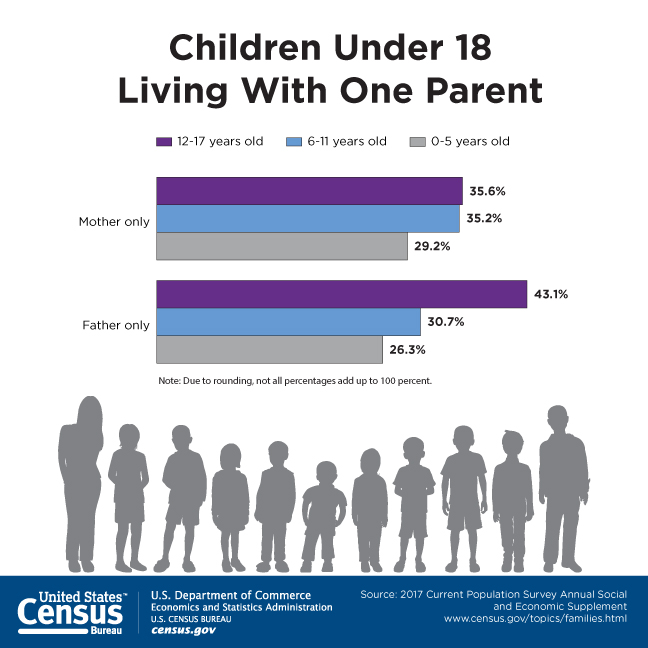The percentage of children living with one parent who live with just their father saw an increase from 12.5 percent in 2007 to 16.1 percent in 2017. That’s according to new statistics from the U.S. Census Bureau’s 2017 America’s Families and Living Arrangements table package.
“A higher percentage of children living with one parent live with their fathers than a decade ago,” said Rose Kreider, a demographer in the Fertility and Family Statistics Branch at the Census Bureau. “However, the majority of children living with one parent still live with their mothers.”
In 2017, 83.9 percent of children living with one parent live with their mothers, compared to 86.0 percent in 2012 and 87.5 percent in 2007.
Overall, nearly 20 million children under age 18 live with one parent, composing 27.1 percent of all living arrangements for children under age 18. In 2007, 25.8 percent of children under age 18 lived with one parent, and in 2012, one of the highest intervening years, 28.3 percent of children under age 18 lived with one parent.
Of children who live with one parent, the most common marital status of the mother is never married (49 percent). The most common marital status of the father is divorced (43 percent). For children who live with their mother only, the largest proportions are ages 6 to 11 (36 percent), and ages 12 to 17 (35 percent). For children who live with their father only, the largest proportions are ages 12 to 17 (43 percent), followed by the proportion ages 6 to 11 (31 percent).
“The age distribution of children under age 18 who live with one parent shows a higher proportion of children living with their mother only are younger than children living with their father only,” Kreider said.
There continues to be racial and ethnic variation in living arrangements for children under age 18. Today, over half (52.8 percent) of black alone children live with one parent, compared to 29.1 percent of Hispanic children and 22.4 percent of white alone children.

Other highlights:
- White householders make up 79 percent of all households in the United States, down from 89 percent in 1970. Black and Hispanic householders each make up 13 percent of households, while Asian householders comprise 5 percent. (Hispanics may be any race so percentages will not add to 100.)
- Households have grown smaller over time, reflecting the decrease in family size and the rise of living alone. The average number of people living in each household has declined from 3.7 people in 1940 to 2.5 today.
- In 2017, there are 35.3 million single-person households, composing 28 percent of all households. In 1960, single-person households represented only 13 percent of all households.
- Today less than 1 in 10 households (9 percent) have five or more people living in them – a decrease from 23 percent of households in 1960.
- In 2017, the median age when adults first marry is 29.5 for men and 27.4 for women, up from ages 23.7 and 20.5, respectively, in 1947. In 2017, less than one-third of all adults (32 percent) have never been married, up from 23 percent in 1950.
- More men (35 percent) than women (29 percent) have never been married in 2017 compared to 26 percent of men and 20 percent of women in 1950.
- Married couples make up 69 percent of all families with children under age 18, compared to 93 percent in 1950.
- In 19 percent of married-couple households, neither the husband nor wife is in the labor force. Among married-couple households with neither spouse in the labor force, 75 percent are age 65 and older.
- Over a quarter (26 percent) of children under the age of 15 who live in married-couple families have a stay at home mother, compared to only 1 percent who have a stay at home father.
- Over half (55 percent) of young adults ages 18 to 24 live in the parental home, compared to 16 percent of young adults ages 25 to 34.
- Of the 64 million parents living with children under the age of 18, 4.9 million (8 percent) are unmarried cohabiting parents.
- Most adults between the ages of 65 to 74 still live with a spouse. For men in this age group, 72 percent live with a spouse, while for women the percentage is 56 percent. For adults age 75 and older, however, the percentage of those living with a spouse drops to 66 percent for men and just 33 percent for women.
- In 2017, there are 7.8 million unmarried opposite-sex couples living together.
- Of the unmarried opposite-sex couples living together, 37 percent live with children under the age of 18.
- Statistics about same-sex couples are available from the American Community Survey.
For more information, see Families and Living Arrangements or visit census.gov.